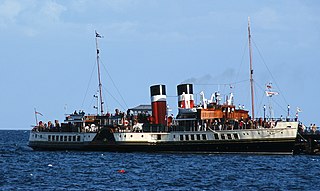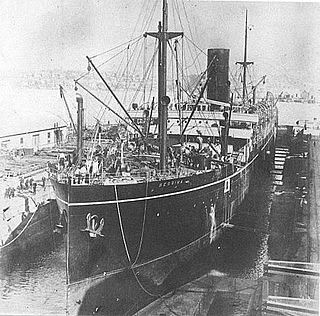
A steamship, often referred to as a steamer, is a type of steam-powered vessel, typically ocean-faring and seaworthy, that is propelled by one or more steam engines that typically move (turn) propellers or paddlewheels. The first steamships came into practical usage during the early 19th century; however, there were exceptions that came before. Steamships usually use the prefix designations of "PS" for paddle steamer or "SS" for screw steamer. As paddle steamers became less common, "SS" is incorrectly assumed by many to stand for "steamship". Ships powered by internal combustion engines use a prefix such as "MV" for motor vessel, so it is not correct to use "SS" for most modern vessels.

IHI Corporation, formerly known as Ishikawajima-Harima Heavy Industries Co., Ltd. is a Japanese engineering corporation headquartered in Tokyo, Japan that produces and offers ships, space launch vehicles, aircraft engines, marine diesel engines, gas turbines, gas engines, railway systems, turbochargers for automobiles, plant engineering, industrial machinery, power station boilers and other facilities, suspension bridges and other structures.

PS Waverley is the last seagoing passenger-carrying paddle steamer in the world. Built in 1946, she sailed from Craigendoran on the Firth of Clyde to Arrochar on Loch Long until 1973. Bought by the Paddle Steamer Preservation Society (PSPS), she has been restored to her 1947 appearance and now operates passenger excursions around the British coast.

The Fairfield Shipbuilding and Engineering Company, Limited, was a Scottish shipbuilding company in the Govan area on the Clyde in Glasgow. Fairfields, as it is often known, was a major warship builder, turning out many vessels for the Royal Navy and other navies through the First World War and the Second World War. It also built many transatlantic liners, including record-breaking ships for the Cunard Line and Canadian Pacific, such as the Blue Riband-winning sisters RMS Campania and RMS Lucania. At the other end of the scale, Fairfields built fast cross-channel mail steamers and ferries for locations around the world. These included ships for the Bosporus crossing in Istanbul and some of the early ships used by Thomas Cook for developing tourism on the River Nile.
Lithgows Limited is a family-owned Scottish company that had a long involvement in shipbuilding, based in Kingston, Port Glasgow, on the River Clyde in Scotland. It has a continued involvement in marine resources.
George Forrester and Company was a British marine engine and locomotive manufacturer at Vauxhall Foundry in Liverpool, established by Scottish engineer George Forrester. The company opened in 1827 as iron founders and commenced building steam locomotives in 1834.

The Mitsubishi Colt 800 is the first of a series of passenger cars with a fastback/hatchback design produced by Mitsubishi Motors from November 1965. It was introduced as a two-door fastback sedan, the first such design in the Japanese market. The series was discontinued in 1971, after the introduction of the company's Galant sedan but without a real replacement.
Basildon was a 1,055 gross register tons (GRT) coaster that was built in 1945 as Empire Bromley for the Ministry of War Transport (MoWT). She was sold into civil service in 1946 and renamed Levenwood. Another change of ownership saw her renamed Basildon and she served under this name until scrapped in 1967.

Caird & Company was a Scottish shipbuilding and engineering firm based in Greenock. The company was established in 1828 by John Caird when he received an order to re-engine Clyde paddle-tugs.
PS Thomas Dugdale was a paddle steamer passenger vessel operated by the London and North Western Railway and the Lancashire and Yorkshire Railway from 1873 to 1883.

Maudie was a 4,661 GRT tanker that was built in 1920 by Lithgows, Port Glasgow, Scotland. Laid down as War Peshwa for the British Shipping Controller, she was completed as Maudie for a Norwegian company. In 1937, she was sold to Finland and renamed Angra. A further sale in 1942 saw her renamed Mercator.
SS Empire Dell was a 7,065 GRT CAM ship that was built in 1941 by Lithgows Ltd, Port Glasgow, United Kingdom for the Ministry of War Transport (MoWT). She served until May 1942, when she was torpedoed and sunk by U-124 whilst a member of Convoy ONS 92.
Empire Dew was a 7,005 GRT Cargo ship that was built in 1940 by Lithgows Ltd, Port Glasgow, United Kingdom for the Ministry of War Transport (MoWT). She was torpedoed and sunk by U-48 in 1941.

David & William Henderson and Company was a Scottish marine engineering and shipbuilding company, based on Clydeside. It was founded in 1872 and traded until 1936. Its shipyard was on the north bank of the River Clyde at its confluence with the River Kelvin.

PS Canberra is an original paddle steamer operated by Murray River Paddlesteamers in Echuca.

SS Ithaka is a wrecked steam freighter and landmark on the coast of Hudson Bay near Churchill, Manitoba. Originally built as the lake freighter Frank A. Augsbury for the Canadian George Hall Coal & Shipping Corporation in 1922, she went on to sail for a variety of different owners in different locations being renamed to Granby in 1927, Parita II in 1948, Valbruna in 1951, Lawrencecliffe Hall in 1952, Federal Explorer in 1955 and finally Ithaka in 1960, before being wrecked later that year.
SS Creekirk was a cargo steamship that was built in Scotland in 1912 and sunk with all hands by a German submarine in 1940. At her launch in 1912 she was named SS Mariston. In her 28-year career she was renamed SS Milcovul in 1913, SS Hyphaestos in 1933 and SS Creekirk in 1938.

SS Orteric was a Bank Line cargo and passenger steamship that was built in Scotland in 1910–11 and sunk by a U-boat in the Mediterranean Sea in 1915. In 1911 she took 960 Spanish and 565 Portuguese migrants to Hawaii to work on the sugar plantations.
SS Marsland was an English cargo vessel, constructed in 1926. She is most notable for running aground and wrecking on the Vestal Rocks, at North Head, just outside the city of St. John's, Newfoundland.












